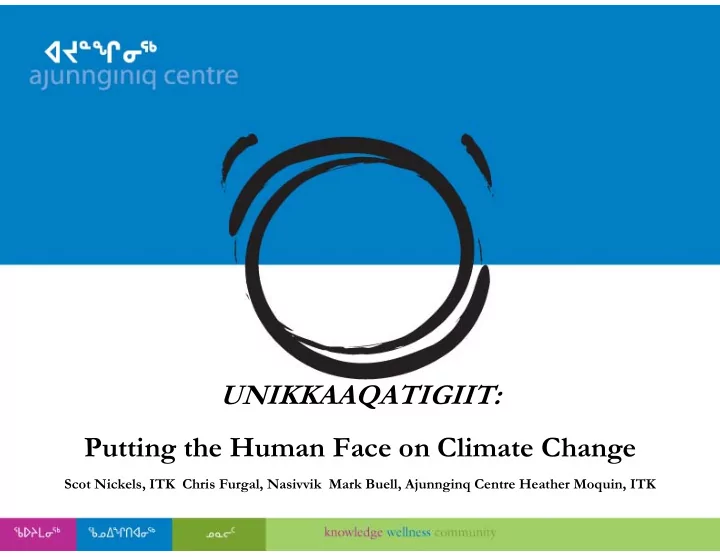

UNIKKAAQATIGIIT: Putting the Human Face on Climate Change Scot Nickels, ITK Chris Furgal, Nasivvik Mark Buell, Ajunnginq Centre Heather Moquin, ITK
Context •About 46,000 Inuit in Canada •On almost every indicator, Inuit fair worse than any other group of Canada •Life expectancy in 2001: Inuit male 62.6 years; Cdn. Average 77.0 years •Inuit are vulnerable to change - climate change is just one of a number of pressures on Inuit society •ACIA - climate change happens first and most severe in the northern regions
� Joint publication � Joint publication of LCOs LCOs, ITK, , ITK, of Nasivvik, Nasivvik, Ajunnginiq Centre Ajunnginiq Centre � Synopsis of � Synopsis of observations, observations, findings, and findings, and perspectives from perspectives from the series of the series of workshops workshops
Partners
Objectives • Document local observations and perspectives of current climate related changes and their impacts • Identify existing, and develop new adaptation strategies • Identify needs for impacts and adaptation research and action related to climate and health in Inuit communities. • Facilitate information exchange among and between Inuit communities
Methodology Training Session Training Session Agenda Identification Agenda Identification Observation Identification Observation Identification Timeline Identification Timeline Identification Effects Identification Effects Identification Adaptation Strategies Adaptation Strategies Planning Planning Indicator Identification Indicator Identification Community meeting and validation Community meeting and validation Analysis and synthesis Analysis and synthesis Dissemination Dissemination
Impacts of Change • Culture and knowledge • Harvesting activities • Travel • Food • Water • Vehicles and equipment • Infrastructure and housing • Economy • Health
Environmental Changes Region Compartment More unpredictable All regions Weather More extreme events - fast coming storms All regions Inuit Observations of Change Changes in precipitation (snow and rain) regimes (timing and All regions amounts) Changes in predominant wind direction NV/I/NU Temperature General warming year round All More hot days in summer I/L Less cold stretches in winter I/NU/L Ice Distribution of ice All regions Timing of freeze-up and break up All regions Ice thickness in winter All regions Wildlife, Fish and Changes in distribution All regions Birds Changes in calving time and location of caribou All regions New species All regions Disappearance of some species I Changes in condition / health All regions Sunlight More intense All regions
“The sun gives us a tan and it goes deeper in children now. We are getting sunburns, and our lips get cracked. We have to go to the health centre to get treatment for these burns” (Repulse Bay, Nunavut) “There are so many changes the older generations are not able to teach our children about these things anymore” (Puvirnituq, Nunavik)
“We can’t make dry fish as the heat spoils it. The sun makes it too hot and we need to put a tarp over top now to protect the fish from the sun” (Inuvik, ISR) “ The water from some rivers and ponds smells and tastes bad, particularly when it does not rain for quite some time. We do not drink this water” (Nunatsiavut)
Warmer temperatures / Increased UV exposure • Increased risk of sun burns, skin cancer, aging of skin, cataracts, anti-immune diseases • Observed increase in headaches and cases of dehydration • Impact on animal & plant food sources affecting nutrition and consumption of traditional foods (fewer berries, skinnier fish, etc… ) • Difficulty in drying fish, caribou • Meat spoils faster • UV - Lichen - Caribou - Travel - Inuit
Access to Country Foods • Reduced quality of food sources, changed taste and decreased nutrients - not as desirable • Poorer quality of meat observed • Changes to migration patterns, need to travel further, increased risk • More unpredictable weather and extreme weather events makes travel more difficult, limiting time out on the land • Fewer and poorer quality berries • Diet affected from decrease in availability of traditional foods can lead to food insecurity, greater consumption of store bought foods causing diabetes, obesity, and cardiovascular diseases, etc…
Water Quality •Warmer temperature - increased algae growth in freshwater sources •Some freshwater sources have disappeared •Concerns expressed about quality of municipal water •Need to carry bottled water when out on land, increased costs
Mental Health • Disruption of livelihood and loss of social identity can affect mental health & well-being • Changes to regular seasonal behaviour resulting in an increase in “spring fever” • Physical, mental and culture loss when a season is missed or shortened • Fear of “change” • Disappearance of some bird species missed
New species of insects, increase in mosquito, black flies • Increased exposure to disease (esp. West Nile Virus • Fly bites can cause rashes • Fear of unknown insects - mental health impacts
Acknowledgements � Community Residents � Community Residents � Land Claim Organizations and Community � Land Claim Organizations and Community organizations (Nunatsiavut Nunatsiavut, Nunavik, Nunavut, , Nunavik, Nunavut, organizations ( Inuvialuit). Inuvialuit). � Northern Ecosystem Initiative (NEI) � Northern Ecosystem Initiative (NEI) � Canadian Institutes for Health Research � Canadian Institutes for Health Research � Climate Change Action Fund � Climate Change Action Fund � Health Canada � Health Canada � MSSS � MSSS- -Qu Qué ébec bec � Nasivvik Centre for Inuit Health and Changing � Nasivvik Centre for Inuit Health and Changing Environments Environments � International Institute for Sustainable � International Institute for Sustainable Development Development � The Ajunnginiq Centre at the National � The Ajunnginiq Centre at the National Aboriginal Health Organization Aboriginal Health Organization
“We used to be able to lie on the land and smell its sweetness. It used to be comfortable with plants and flowers” (Paulatuk, ISR)
Recommend
More recommend